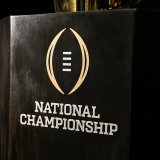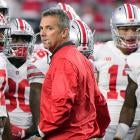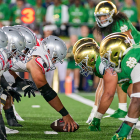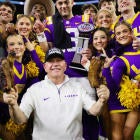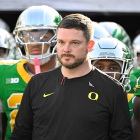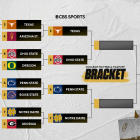Hate preseason national and conference polls? Don't worry, we have you covered.
Yes, we here at CBS Sports have our CBS Sports 130, which only adds to the preseason polls released by the Associated Press and USA Today. But these are polls clearly designed for fun and debate. They're a way to pass the time before the real games get going. They're harmless. Don't get too worked up over them. Besides, we won't know much about each team until we get to about mid-October.
However, if you want preseason projections without the offseason hype, allow us to project each Power Five conference champion, plus this season's national champion, based on past trends. To be clear, these aren't projections based on last year's results. Every team, no matter its returning roster, is different from year to year. Rather, we're looking at themes across each conference from the past five seasons (2012-16) to determine what's important in winning titles. For some conferences, explosive offenses rule the day. For others, stout defensive lines are the key. While certain stats are always important, no two conferences are exactly the same.
As a bonus, we're revisiting last year's predictions to see if they held up. If not, we looked at different numbers to find a new trend. Before starting, there are two things to keep in mind ...
No. 1 -- Variety is not the spice of life: There are 64 Power Five programs. Over the past five years, only 15 different programs have won at least a share of a conference championship. That's roughly 23 percent. Seven of those programs were multiple conference title winners.
Additionally, of the four power conferences with divisions, three -- the ACC, Pac-12 and SEC -- have produced a title winner from just one division. The exception is the Big Ten, and that's not even a great example because the divisions were realigned in 2014. In the ACC, it has been a two-team race with Clemson and Florida State.
What I'm trying to say is don't expect a ton of variation here.
No. 2 -- As such, preseason predictions usually aren't that far off: It's not as accurate to say media predictions get it wrong so much as they come close. For example: ACC media predicted Clemson would win the ACC in 2013. The Tigers finished second in the Atlantic Division while Florida State, picked to finish second in the Atlantic, won it all. In the Big Ten, Ohio State has understandably been the preseason favorite in three of the past five years. Twice the Buckeyes lost the tiebreaker in the East Division. In 2013, they lost in the Big Ten title game.
There are occasional breakthroughs, sure. Penn State was a surprise team last season. So was Auburn four years ago. And of the five power conferences, the Big 12 has had the most variance by our sample size. If anything, conference predictions are more like a game of horseshoes.
With those in mind, here's how each Power Five conference has played out over the past five seasons versus media predictions along with their primary trends.
ACC
| Year | Predicted conference champion (media) | Actual conference champion |
|---|---|---|
2016 | Clemson | Clemson |
2015 | Clemson | Clemson |
2014 | Florida State | Florida State |
2013 | Clemson (finished 2nd in Atlantic) | Florida State (predicted 2nd in Atlantic) |
2012 | Florida State | Florida State |
Last year's trend to watch: Since 2011, the ACC champion has also led the conference in explosive plays (plays of 10-plus yards). Furthermore, the eventual champ finished either first or second in the number of plays of at least 20 yards.
Did it prove true? Yes. The Tigers not only had more plays of 10-plus yards than anyone else in the ACC, they led the nation in that category. Clemson also finished second in the ACC behind Louisville in plays of at least 20 yards. That was good enough to finish in the top 10 nationally.
What to look for in 2017: Explosive plays are an important component for any successful offense, but it helps to have a talented, proven quarterback who can contribute to them. No quarterback in the country was more explosive than Louisville's Lamar Jackson last season. He's the leading returning quarterback in plays of at least 10 yards and tied for second in plays of 20 yards or more.
It has been a two-team show in the ACC for years now. Clemson and Florida State have top-10 coaches, recruit at a championship level and annually churn out several NFL Draft picks. Historically speaking, it makes sense that the Seminoles are preseason picks to win the conference. But by the letter of our law, can the Florida State offense produce enough big plays with 1) the departure of running back Dalvin Cook; 2) pass protection that has been off and on; and 3) the lack of a big-name wideout? Florida State still ranked highly in big-play categories last year.
Predicted champion: Louisville. Having a player of Jackson's caliber -- and he's only getting better as a passer -- is a difference maker. If Louisville's offensive line shores up its protection, Jackson should have an even bigger year, if you can imagine that. Additionally, there's a lot of quarterback turnover in the ACC this year. Having Jackson back is a huge leg up for the Cardinals.
Big Ten
| Year | Predicted conference champion (media) | Actual conference champion |
|---|---|---|
2016 | Ohio State (Lost tiebreaker in East) | Penn State (predicted 4th in East) |
2015 | Ohio State (Lost tiebreaker in East) | Michigan State (predicted 2nd in East) |
2014 | Michigan State* (finished 2nd in East) | Ohio State (predicted 2nd in East) |
2013 | Ohio State (finished 1st in Leaders, lost in Big Ten title) | Michigan State (predicted 3rd in Legends) |
2012 | Michigan (finished 2nd in Legends) | Wisconsin (predicted 1st in Leaders, finished 3rd^) |
* Cleveland.com reissued its poll after the injury to Ohio State quarterback Braxton Miller, naming Michigan State its new champion. However, the site did not rerank each team.
^ Ohio State and Penn State were ineligible for postseason play.
Last year's trend: Who's going to take the ball away? In four of the last five years, the eventual Big Ten champ has finished first or second in the conference in total takeaways. The exception was Wisconsin in 2012, but that's also a bit misleading as the Badgers finished third in the Leaders division. However, since Ohio State and Penn State were ineligible for postseason play, Wisconsin made it to the Big Ten title, shocking Nebraska 70-31.
Did it prove true? Not really. Penn State finished with 21 takeaways spread evenly throughout the season and a final turnover margin of +1. That was sixth in the Big Ten and tied for 53rd nationally. In some ways, it's understandable that this trend didn't prove to be a factor. After all, turnover stats don't account for being in the right place at the right time.
What to look for in 2017: In pivoting from turnovers, another defensive stat stood out: sacks. Four of the past five Big Ten champs have finished no lower than third in the conference in that category. And tackles for loss stats naturally showed a strong correlation as well. The more disruptive a Big Ten defense has been, the more likely it was competing for a conference -- or, at the very least, divisional -- title.
Predicted champion: Ohio State. The Buckeyes had 28 sacks last season -- tied for seventh in the Big Ten -- but they return about 91 percent of their sack production. The defensive line has quality depth and a starting unit that features a beautiful mesh of veteran players like Tyquan Lewis and younger guys like Nick Bosa and Sam Hubbard. Penn State, and even Maryland, had an argument as well.
Big 12
| Year | Predicted conference champion (media) | Actual conference champion |
|---|---|---|
2016 | Oklahoma | |
2015 | TCU (finished 3rd) | Oklahoma (predicted 3rd) |
2014 | Oklahoma (finished T4) | Baylor, TCU (predicted 2nd, 7th) |
2013 | Oklahoma State (finished T3) | Baylor (predicted 5th) |
2012 | Oklahoma | Kansas State, Oklahoma (predicted 6th, 1st) |
Last year's trend: Who knows? The Big 12, as mentioned before, has been one big casserole of absurdity. Unlike other power conferences, the Big 12 actually gives hope for the dark horses of the college football world. For all we know, Texas has a real shot at this thing in 2016.
Did it prove true? Nope. The opposite, in fact. Oklahoma was the preseason favorite and went unbeaten in conference play -- the first time that has happened since the Big 12 went to its round-robin schedule. Going wire to wire like that is rare, so give the Sooners credit.
What to look for in 2017: Let's lean on old faithful instead. Quarterback play matters in the Big 12. But the dirty little secret is that you don't need to throw for the most yards or touchdowns to win the Big 12. Baker Mayfield's numbers, while impressive during his two years in Norman, weren't the most prolific in the conference. Efficiency matters, and Mayfield has had the highest QB rating in the Big 12 in each of the past two seasons. What will be interesting to watch as a follow-up is whether the Sooners have a No. 1 wideout -- a Sterling Shepard or Dede Westbrook type -- to catch all those passes.
Predicted champion: Oklahoma ... but Oklahoma State checks off an awful lot of boxes, too.
Pac-12
| Year | Predicted conference champion (media) | Actual conference champion |
|---|---|---|
2016 | Stanford (finished third in North) | Washington (predicted 2nd in North) |
2015 | USC (finished 1st in South, lost title game) | Stanford (predicted 2nd in North) |
2014 | Oregon | |
2013 | Oregon (Lost tiebreaker in North) | Stanford (predicted 2nd in North) |
2012 | USC (finished 2nd in South) | Stanford (predicted 2nd in North) |
Last year's trend: Strong ground games have mattered. Oregon has been the Pac-12's rushing champion in each of the last five seasons, while Stanford has had three 1,000-yard rushers and one 2,000-yard rusher, Christian McCaffrey, who was also a Heisman finalist in 2015.
Did it prove true? For the most part. Washington didn't have the top rushing offense in the Pac-12, but it finished in the top three in yards and yards per rush. Myles Gaskin finished behind only McCaffrey with 1,373 yards on the ground.
What to look for in 2017: There's a deep quarterback group in the Pac-12, but if we're sticking to our trend, a few teams make the cut. Washington is one for reasons stated above. Southern California is another. Running back Ronald Jones II averaged 6.1 yards per carry in 2016, second highest among returning Pac-12 runners with at least 10 rushing attempts per game. Stanford's Bryce Love was another explosive option to McCaffrey and averaged 13.85 yards per carry in the Cardinal's opener against Rice (yes, it was Rice). Oregon's Royce Freeman has battled through injuries, but he still almost had 1,000 yards a season ago and is the conference's most proven back. Colorado's Phillip Lindsay had the second-most attempts per game behind McCaffrey and the fourth-highest yardage total.
Predicted champion: Washington. Stanford makes a compelling case because of its one-two punch with Love and Cameron Scarlett, but Gaskin and Lavon Coleman are the more proven duo.
SEC
| Year | Predicted conference champion (media) | Actual conference champion |
|---|---|---|
2016 | Alabama | |
2015 | Auburn* (finished 7th in West) | Alabama (predicted 1st in West) |
2014 | Alabama | Alabama |
2013 | Alabama (lost tiebreaker West) | Auburn (predicted 5th in West) |
2012 | LSU (finished 2nd in West) | Alabama (predicted 2nd in West) |
*Though Alabama was predicted to win the SEC West, Auburn received more votes as the SEC champion.
Last year's trend: If there's one unit the SEC leans on, it's a strong defensive line. No conference does it better at the top. It shouldn't be too much of a surprise that no SEC team has stopped the run better than Alabama over the last five seasons. The Tide have given up an average of 2.76 yards per rush in that span. Additionally, teams appearing in the SEC Championship Game have finished at or near the top of the league in sacks -- including Missouri in the 2013 and 2014 East title runs.
Did it prove true? Um, that would be a resounding "yes." The Crimson Tide's defensive dominance was unreal. That run defense, anchored by a deep front seven, gave up 2 yards per rush and just five touchdowns the entire season.
What to look for in 2017: More of the same. The SEC's quarterback situation is on the rise, but the bread and butter for many teams remains in the ground game. And with backs like Nick Chubb (Georgia), Kamryn Pettway (Auburn) and Derrius Guice (LSU), why not focus on stopping the run?
Predicted champion: Alabama. Dominating the line of scrimmage is so critical and Alabama does it better than anyone. The question is: Can another team show the same type of dominance? That might determine if that team can upend the Tide. The problem is that it's very hard to beat Alabama at its own game.
Predicting the College Football Playoff
It has been said before, but it's always worth repeating: Recruiting is an inexact science, but if you want to compete for a national championship -- like, legitimately compete -- you have to win on the recruiting trail. Alabama's Nick Saban and Ohio State's Urban Meyer are two of the best coaches in the game today, and they're that good in part because they get a high ratio of blue-chip talent on campus. Here are how the past five national champions have fared in the two NFL Drafts following their title run ...
| Year | Champion | First Draft after Title | Second Draft after Title |
|---|---|---|---|
2016 | Clemson | 6 players (2017) | TBD (2018) |
2015 | Alabama | 7 players (2016) | 10 players (2017) |
2014 | Ohio State | 5 players (2015) | 12 players (2016) |
2013 | Florida State | 6 players (2014) | 11 players (2015) |
2012 | Alabama | 9 players (2013) | 8 players (2014) |
Of our five predicted Power Five champions, only Alabama and Ohio State recruit at that type of high-end level. One interesting note: Since 2013, the team that won the national championship actually sent more players to the NFL two years later.
Predicted champion: Ohio State. The Buckeyes have four top-50 prospects in Matt Miller's way-too-early draft big board for 2018 and three top-50 players, per CBS Sports. Alabama also has a strong case, and some non-predicted playoff teams like USC and Florida State are stacked with top-end draft talent as well.




